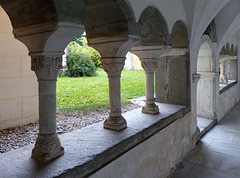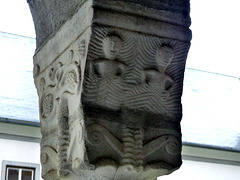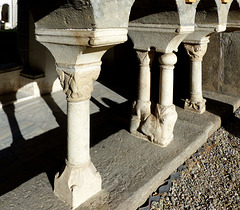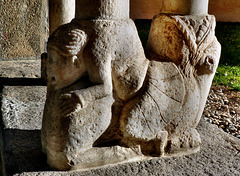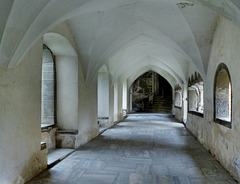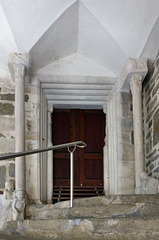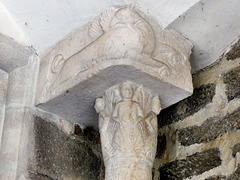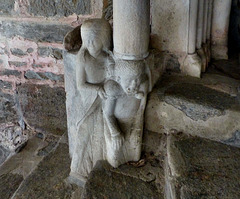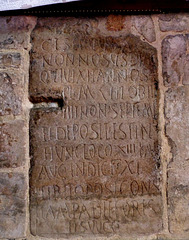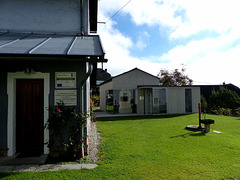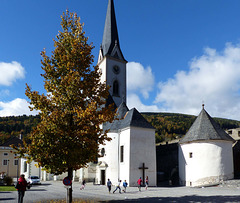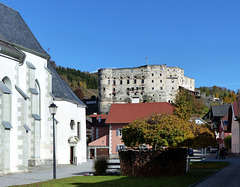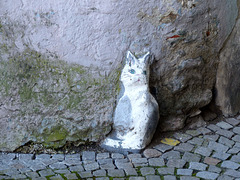
Carinthia / Kaernten
All photos were taken in Carinthia, the southernmost Austrian state.
Millstatt am See - Stift Millstatt
| |
|
|
|
Stift Millstatt ("Millstatt Abbey") was founded by the Aribo II and Boto, members of Aribonids, a noble, Bavarian family, around 1070.
Run by Benedictine monks and protected by Papal deeds Stift Millstatt prospered in the early years and a nunnery was added.
Within the 13th century, the decay began. As the abbey had secular Church Vogts, it suffered strongly under the political powergames of that timne and finaly ended 1456 under the House of Habsburg. At that time only 10 monks still lived here.
Emperor Frederick III reached a papal bull in 1469, so that the military order of the Knights of Saint George took over Stift Millstatt in order to fight the invading troops of the Ottoman Empire.
The order now had to cope with the debts left by the Benedictines and the redevelopment of the neglected premises. While the knights were engaged with the fortification of the monastery, they failed to protect the region. Millstatt was heavily devastated by the Turks in 1478, followed by Hungarian troops in 1487. As the power of the knightly order declined, unrests and revolts arose among the peasants.
As the new Protestant belief spread in the area the monastery vested the Society of Jesus ("Jesuits") in 1598 to support the Counter-Reformation.
The monks were disliked by the population for their stern measures. In 1737 the displeasure culminated in open revolt, when peasants ganged up and stormed the monastery. The rule of the Jesuits ended, when the order was suppressed by Pope Clement XIV in 1773. The monks had to leave Millstatt.
Today the former abbey-church serves the parish, while the other buildings belong to the Austrian state and host the "Österreichische Bundesforste" (Austrian State Forestry Commission).
The church underwent numerous alterations over the centuries. It did not only suffer from fires, but as well from earthquakes. A strong quake in 1690 heavily damaged the western facade.
The old cloister has some very interesting capitals.
Millstatt am See - Stift Millstatt
| |
|
Stift Millstatt ("Millstatt Abbey") was founded by the Aribo II and Boto, members of Aribonids, a noble, Bavarian family, around 1070.
Run by Benedictine monks and protected by Papal deeds Stift Millstatt prospered in the early years and a nunnery was added.
Within the 13th century, the decay began. As the abbey had secular Church Vogts, it suffered strongly under the political powergames of that timne and finaly ended 1456 under the House of Habsburg. At that time only 10 monks still lived here.
Emperor Frederick III reached a papal bull in 1469, so that the military order of the Knights of Saint George took over Stift Millstatt in order to fight the invading troops of the Ottoman Empire.
The order now had to cope with the debts left by the Benedictines and the redevelopment of the neglected premises. While the knights were engaged with the fortification of the monastery, they failed to protect the region. Millstatt was heavily devastated by the Turks in 1478, followed by Hungarian troops in 1487. As the power of the knightly order declined, unrests and revolts arose among the peasants.
As the new Protestant belief spread in the area the monastery vested the Society of Jesus ("Jesuits") in 1598 to support the Counter-Reformation.
The monks were disliked by the population for their stern measures. In 1737 the displeasure culminated in open revolt, when peasants ganged up and stormed the monastery. The rule of the Jesuits ended, when the order was suppressed by Pope Clement XIV in 1773. The monks had to leave Millstatt.
Today the former abbey-church serves the parish, while the other buildings belong to the Austrian state and host the "Österreichische Bundesforste" (Austrian State Forestry Commission).
The church underwent numerous alterations over the centuries. It did not only suffer from fires, but as well from earthquakes. A strong quake in 1690 heavily damaged the western facade.
The old cloister has some very interesting capitals. Here are two persons taking a bath.
Millstatt am See - Stift Millstatt
| |
|
|
|
Stift Millstatt ("Millstatt Abbey") was founded by the Aribo II and Boto, members of Aribonids, a noble, Bavarian family, around 1070.
Run by Benedictine monks and protected by Papal deeds Stift Millstatt prospered in the early years and a nunnery was added.
Within the 13th century, the decay began. As the abbey had secular Church Vogts, it suffered strongly under the political powergames of that timne and finaly ended 1456 under the House of Habsburg. At that time only 10 monks still lived here.
Emperor Frederick III reached a papal bull in 1469, so that the military order of the Knights of Saint George took over Stift Millstatt in order to fight the invading troops of the Ottoman Empire.
The order now had to cope with the debts left by the Benedictines and the redevelopment of the neglected premises. While the knights were engaged with the fortification of the monastery, they failed to protect the region. Millstatt was heavily devastated by the Turks in 1478, followed by Hungarian troops in 1487. As the power of the knightly order declined, unrests and revolts arose among the peasants.
As the new Protestant belief spread in the area the monastery vested the Society of Jesus ("Jesuits") in 1598 to support the Counter-Reformation.
The monks were disliked by the population for their stern measures. In 1737 the displeasure culminated in open revolt, when peasants ganged up and stormed the monastery. The rule of the Jesuits ended, when the order was suppressed by Pope Clement XIV in 1773. The monks had to leave Millstatt.
Today the former abbey-church serves the parish, while the other buildings belong to the Austrian state and host the "Österreichische Bundesforste" (Austrian State Forestry Commission).
The church underwent numerous alterations over the centuries. It did not only suffer from fires, but as well from earthquakes. A strong quake in 1690 heavily damaged the western facade.
The old cloister has some very interesting capitals. Note the base of the two pillars in the center. A lion (right) - and a person (left) riding on the lion´s back.
Millstatt am See - Stift Millstatt
| |
|
|
Stift Millstatt ("Millstatt Abbey") was founded by the Aribo II and Boto, members of Aribonids, a noble, Bavarian family, around 1070.
Run by Benedictine monks and protected by Papal deeds Stift Millstatt prospered in the early years and a nunnery was added.
Within the 13th century, the decay began. As the abbey had secular Church Vogts, it suffered strongly under the political powergames of that timne and finaly ended 1456 under the House of Habsburg. At that time only 10 monks still lived here.
Emperor Frederick III reached a papal bull in 1469, so that the military order of the Knights of Saint George took over Stift Millstatt in order to fight the invading troops of the Ottoman Empire.
The order now had to cope with the debts left by the Benedictines and the redevelopment of the neglected premises. While the knights were engaged with the fortification of the monastery, they failed to protect the region. Millstatt was heavily devastated by the Turks in 1478, followed by Hungarian troops in 1487. As the power of the knightly order declined, unrests and revolts arose among the peasants.
As the new Protestant belief spread in the area the monastery vested the Society of Jesus ("Jesuits") in 1598 to support the Counter-Reformation.
The monks were disliked by the population for their stern measures. In 1737 the displeasure culminated in open revolt, when peasants ganged up and stormed the monastery. The rule of the Jesuits ended, when the order was suppressed by Pope Clement XIV in 1773. The monks had to leave Millstatt.
Today the former abbey-church serves the parish, while the other buildings belong to the Austrian state and host the "Österreichische Bundesforste" (Austrian State Forestry Commission).
The church underwent numerous alterations over the centuries. It did not only suffer from fires, but as well from earthquakes. A strong quake in 1690 heavily damaged the western facade.
The old cloister has some very interesting capitals.
These are the same pillars as seen (from the other side) on the previous upload. The lion (right) - and a person (left) riding on the lion´s back. Actually the person is not "riding" - as he is facing backwards.
Millstatt am See - Stift Millstatt
| |
|
|
Stift Millstatt ("Millstatt Abbey") was founded by the Aribo II and Boto, members of Aribonids, a noble, Bavarian family, around 1070.
Run by Benedictine monks and protected by Papal deeds Stift Millstatt prospered in the early years and a nunnery was added.
Within the 13th century, the decay began. As the abbey had secular Church Vogts, it suffered strongly under the political powergames of that timne and finaly ended 1456 under the House of Habsburg. At that time only 10 monks still lived here.
Emperor Frederick III reached a papal bull in 1469, so that the military order of the Knights of Saint George took over Stift Millstatt in order to fight the invading troops of the Ottoman Empire.
The order now had to cope with the debts left by the Benedictines and the redevelopment of the neglected premises. While the knights were engaged with the fortification of the monastery, they failed to protect the region. Millstatt was heavily devastated by the Turks in 1478, followed by Hungarian troops in 1487. As the power of the knightly order declined, unrests and revolts arose among the peasants.
As the new Protestant belief spread in the area the monastery vested the Society of Jesus ("Jesuits") in 1598 to support the Counter-Reformation.
The monks were disliked by the population for their stern measures. In 1737 the displeasure culminated in open revolt, when peasants ganged up and stormed the monastery. The rule of the Jesuits ended, when the order was suppressed by Pope Clement XIV in 1773. The monks had to leave Millstatt.
Today the former abbey-church serves the parish, while the other buildings belong to the Austrian state and host the "Österreichische Bundesforste" (Austrian State Forestry Commission).
The church underwent numerous alterations over the centuries. It did not only suffer from fires, but as well from earthquakes. A strong quake in 1690 heavily damaged the western facade.
The old cloister has some very interesting capitals.
The previous uploads give an overview, here are more details. The lion is a so called "pillar-eater" and the person on the lion´s back is a kind of atlas.
Millstatt am See - Stift Millstatt
| |
|
Stift Millstatt ("Millstatt Abbey") was founded by the Aribo II and Boto, members of Aribonids, a noble, Bavarian family, around 1070.
Run by Benedictine monks and protected by Papal deeds Stift Millstatt prospered in the early years and a nunnery was added.
Within the 13th century, the decay began. As the abbey had secular Church Vogts, it suffered strongly under the political powergames of that timne and finaly ended 1456 under the House of Habsburg. At that time only 10 monks still lived here.
Emperor Frederick III reached a papal bull in 1469, so that the military order of the Knights of Saint George took over Stift Millstatt in order to fight the invading troops of the Ottoman Empire.
The order now had to cope with the debts left by the Benedictines and the redevelopment of the neglected premises. While the knights were engaged with the fortification of the monastery, they failed to protect the region. Millstatt was heavily devastated by the Turks in 1478, followed by Hungarian troops in 1487. As the power of the knightly order declined, unrests and revolts arose among the peasants.
As the new Protestant belief spread in the area the monastery vested the Society of Jesus ("Jesuits") in 1598 to support the Counter-Reformation.
The monks were disliked by the population for their stern measures. In 1737 the displeasure culminated in open revolt, when peasants ganged up and stormed the monastery. The rule of the Jesuits ended, when the order was suppressed by Pope Clement XIV in 1773. The monks had to leave Millstatt.
Today the former abbey-church serves the parish, while the other buildings belong to the Austrian state and host the "Österreichische Bundesforste" (Austrian State Forestry Commission).
The church underwent numerous alterations over the centuries. It did not only suffer from fires, but as well from earthquakes. A strong quake in 1690 heavily damaged the western facade.
The old cloister has some very interesting capitals.
The previous uploads give an overview, here are more details. The lion is a so called "pillar-eater" and the person on the lion´s back is a kind of atlas.
Millstatt am See - Stift Millstatt
| |
|
|
|
Stift Millstatt ("Millstatt Abbey") was founded by the Aribo II and Boto, members of Aribonids, a noble, Bavarian family, around 1070.
Run by Benedictine monks and protected by Papal deeds Stift Millstatt prospered in the early years and a nunnery was added.
Within the 13th century, the decay began. As the abbey had secular Church Vogts, it suffered strongly under the political powergames of that timne and finaly ended 1456 under the House of Habsburg. At that time only 10 monks still lived here.
Emperor Frederick III reached a papal bull in 1469, so that the military order of the Knights of Saint George took over Stift Millstatt in order to fight the invading troops of the Ottoman Empire.
The order now had to cope with the debts left by the Benedictines and the redevelopment of the neglected premises. While the knights were engaged with the fortification of the monastery, they failed to protect the region. Millstatt was heavily devastated by the Turks in 1478, followed by Hungarian troops in 1487. As the power of the knightly order declined, unrests and revolts arose among the peasants.
As the new Protestant belief spread in the area the monastery vested the Society of Jesus ("Jesuits") in 1598 to support the Counter-Reformation.
The monks were disliked by the population for their stern measures. In 1737 the displeasure culminated in open revolt, when peasants ganged up and stormed the monastery. The rule of the Jesuits ended, when the order was suppressed by Pope Clement XIV in 1773. The monks had to leave Millstatt.
Today the former abbey-church serves the parish, while the other buildings belong to the Austrian state and host the "Österreichische Bundesforste" (Austrian State Forestry Commission).
The church underwent numerous alterations over the centuries. It did not only suffer from fires, but as well from earthquakes. A strong quake in 1690 heavily damaged the western facade.
The side portal of the former abby church is in the northeastern corner of the cloister. This is from where the monks entered the church. The portal was "remodeled" around 1500, using Romanesque sculptures, that probably were created 1150-1200 for different places.
Millstatt am See - Stift Millstatt
| |
|
|
Stift Millstatt ("Millstatt Abbey") was founded by the Aribo II and Boto, members of Aribonids, a noble, Bavarian family, around 1070.
Run by Benedictine monks and protected by Papal deeds Stift Millstatt prospered in the early years and a nunnery was added.
Within the 13th century, the decay began. As the abbey had secular Church Vogts, it suffered strongly under the political powergames of that timne and finaly ended 1456 under the House of Habsburg. At that time only 10 monks still lived here.
Emperor Frederick III reached a papal bull in 1469, so that the military order of the Knights of Saint George took over Stift Millstatt in order to fight the invading troops of the Ottoman Empire.
The order now had to cope with the debts left by the Benedictines and the redevelopment of the neglected premises. While the knights were engaged with the fortification of the monastery, they failed to protect the region. Millstatt was heavily devastated by the Turks in 1478, followed by Hungarian troops in 1487. As the power of the knightly order declined, unrests and revolts arose among the peasants.
As the new Protestant belief spread in the area the monastery vested the Society of Jesus ("Jesuits") in 1598 to support the Counter-Reformation.
The monks were disliked by the population for their stern measures. In 1737 the displeasure culminated in open revolt, when peasants ganged up and stormed the monastery. The rule of the Jesuits ended, when the order was suppressed by Pope Clement XIV in 1773. The monks had to leave Millstatt.
Today the former abbey-church serves the parish, while the other buildings belong to the Austrian state and host the "Österreichische Bundesforste" (Austrian State Forestry Commission).
The church underwent numerous alterations over the centuries. It did not only suffer from fires, but as well from earthquakes. A strong quake in 1690 heavily damaged the western facade.
The side portal of the former abby church is in the northeastern corner of the cloister. This is from where the monks entered the church. The portal was "remodeled" around 1500, using Romanesque sculptures, that probably were created 1150-1200 for different places.
Millstatt am See - Stift Millstatt
| |
|
Stift Millstatt ("Millstatt Abbey") was founded by the Aribo II and Boto, members of Aribonids, a noble, Bavarian family, around 1070.
Run by Benedictine monks and protected by Papal deeds Stift Millstatt prospered in the early years and a nunnery was added.
Within the 13th century, the decay began. As the abbey had secular Church Vogts, it suffered strongly under the political powergames of that timne and finaly ended 1456 under the House of Habsburg. At that time only 10 monks still lived here.
Emperor Frederick III reached a papal bull in 1469, so that the military order of the Knights of Saint George took over Stift Millstatt in order to fight the invading troops of the Ottoman Empire.
The order now had to cope with the debts left by the Benedictines and the redevelopment of the neglected premises. While the knights were engaged with the fortification of the monastery, they failed to protect the region. Millstatt was heavily devastated by the Turks in 1478, followed by Hungarian troops in 1487. As the power of the knightly order declined, unrests and revolts arose among the peasants.
As the new Protestant belief spread in the area the monastery vested the Society of Jesus ("Jesuits") in 1598 to support the Counter-Reformation.
The monks were disliked by the population for their stern measures. In 1737 the displeasure culminated in open revolt, when peasants ganged up and stormed the monastery. The rule of the Jesuits ended, when the order was suppressed by Pope Clement XIV in 1773. The monks had to leave Millstatt.
Today the former abbey-church serves the parish, while the other buildings belong to the Austrian state and host the "Österreichische Bundesforste" (Austrian State Forestry Commission).
The church underwent numerous alterations over the centuries. It did not only suffer from fires, but as well from earthquakes. A strong quake in 1690 heavily damaged the western facade.
The side portal of the former abby church is in the northeastern corner of the cloister. This is from where the monks entered the church. The portal was "remodeled" around 1500, using Romanesque sculptures, that probably were created 1150-1200 for different places. Here - over the capital - lurks a huge griffon.
Millstatt am See - Stift Millstatt
| |
|
|
|
Stift Millstatt ("Millstatt Abbey") was founded by the Aribo II and Boto, members of Aribonids, a noble, Bavarian family, around 1070.
Run by Benedictine monks and protected by Papal deeds Stift Millstatt prospered in the early years and a nunnery was added.
Within the 13th century, the decay began. As the abbey had secular Church Vogts, it suffered strongly under the political powergames of that timne and finaly ended 1456 under the House of Habsburg. At that time only 10 monks still lived here.
Emperor Frederick III reached a papal bull in 1469, so that the military order of the Knights of Saint George took over Stift Millstatt in order to fight the invading troops of the Ottoman Empire.
The order now had to cope with the debts left by the Benedictines and the redevelopment of the neglected premises. While the knights were engaged with the fortification of the monastery, they failed to protect the region. Millstatt was heavily devastated by the Turks in 1478, followed by Hungarian troops in 1487. As the power of the knightly order declined, unrests and revolts arose among the peasants.
As the new Protestant belief spread in the area the monastery vested the Society of Jesus ("Jesuits") in 1598 to support the Counter-Reformation.
The monks were disliked by the population for their stern measures. In 1737 the displeasure culminated in open revolt, when peasants ganged up and stormed the monastery. The rule of the Jesuits ended, when the order was suppressed by Pope Clement XIV in 1773. The monks had to leave Millstatt.
Today the former abbey-church serves the parish, while the other buildings belong to the Austrian state and host the "Österreichische Bundesforste" (Austrian State Forestry Commission).
The church underwent numerous alterations over the centuries. It did not only suffer from fires, but as well from earthquakes. A strong quake in 1690 heavily damaged the western facade.
The side portal of the former abby church is in the northeastern corner of the cloister. This is from where the monks entered the church. The portal was "remodeled" around 1500, using Romanesque sculptures, that probably were created 1150-1200 for different places.
A devouring monster over a capital with a group of mermaids. The poor victim in the monster´s mouth holds a kind of tool..
Millstatt am See - Stift Millstatt
| |
|
Stift Millstatt ("Millstatt Abbey") was founded by the Aribo II and Boto, members of Aribonids, a noble, Bavarian family, around 1070.
Run by Benedictine monks and protected by Papal deeds Stift Millstatt prospered in the early years and a nunnery was added.
Within the 13th century, the decay began. As the abbey had secular Church Vogts, it suffered strongly under the political powergames of that timne and finaly ended 1456 under the House of Habsburg. At that time only 10 monks still lived here.
Emperor Frederick III reached a papal bull in 1469, so that the military order of the Knights of Saint George took over Stift Millstatt in order to fight the invading troops of the Ottoman Empire.
The order now had to cope with the debts left by the Benedictines and the redevelopment of the neglected premises. While the knights were engaged with the fortification of the monastery, they failed to protect the region. Millstatt was heavily devastated by the Turks in 1478, followed by Hungarian troops in 1487. As the power of the knightly order declined, unrests and revolts arose among the peasants.
As the new Protestant belief spread in the area the monastery vested the Society of Jesus ("Jesuits") in 1598 to support the Counter-Reformation.
The monks were disliked by the population for their stern measures. In 1737 the displeasure culminated in open revolt, when peasants ganged up and stormed the monastery. The rule of the Jesuits ended, when the order was suppressed by Pope Clement XIV in 1773. The monks had to leave Millstatt.
Today the former abbey-church serves the parish, while the other buildings belong to the Austrian state and host the "Österreichische Bundesforste" (Austrian State Forestry Commission).
The church underwent numerous alterations over the centuries. It did not only suffer from fires, but as well from earthquakes. A strong quake in 1690 heavily damaged the western facade.
The side portal of the former abby church is in the northeastern corner of the cloister. This is from where the monks entered the church. The portal was "remodeled" around 1500, using Romanesque sculptures, that probably were created 1150-1200 for different places.
On both sides of the portal are very similar sculptures. Properly dressed ladies hold ugly men. Here the man is in chains. This may stand for the Christianity - and Heathenism.
The chained person reminds me on sculptures in Oloron-Sainte-Marie and Morlaàs (Southern France).
Millstatt am See - Stift Millstatt
| |
|
|
Stift Millstatt ("Millstatt Abbey") was founded by the Aribo II and Boto, members of Aribonids, a noble, Bavarian family, around 1070.
Run by Benedictine monks and protected by Papal deeds Stift Millstatt prospered in the early years and a nunnery was added.
Within the 13th century, the decay began. As the abbey had secular Church Vogts, it suffered strongly under the political powergames of that timne and finaly ended 1456 under the House of Habsburg. At that time only 10 monks still lived here.
Emperor Frederick III reached a papal bull in 1469, so that the military order of the Knights of Saint George took over Stift Millstatt in order to fight the invading troops of the Ottoman Empire.
The order now had to cope with the debts left by the Benedictines and the redevelopment of the neglected premises. While the knights were engaged with the fortification of the monastery, they failed to protect the region. Millstatt was heavily devastated by the Turks in 1478, followed by Hungarian troops in 1487. As the power of the knightly order declined, unrests and revolts arose among the peasants.
As the new Protestant belief spread in the area the monastery vested the Society of Jesus ("Jesuits") in 1598 to support the Counter-Reformation.
The monks were disliked by the population for their stern measures. In 1737 the displeasure culminated in open revolt, when peasants ganged up and stormed the monastery. The rule of the Jesuits ended, when the order was suppressed by Pope Clement XIV in 1773. The monks had to leave Millstatt.
Today the former abbey-church serves the parish, while the other buildings belong to the Austrian state and host the "Österreichische Bundesforste" (Austrian State Forestry Commission).
The church underwent numerous alterations over the centuries. It did not only suffer from fires, but as well from earthquakes. A strong quake in 1690 heavily damaged the western facade.
The side portal of the former abby church is in the northeastern corner of the cloister. This is from where the monks entered the church. The portal was "remodeled" around 1500, using Romanesque sculptures, that probably were created 1150-1200 for different places.
On both sides of the portal are very similar sculptures. Properly dressed ladies hold ugly men. Here the (crowned) lady holds a cross - and has grabbed the thug by his moustache.
Molzbichl - St. Tiburtius
| |
|
Archeologists excavated the foundations of the oldest known monastery in Carinthia around and below the parish church of Molzbichl. This monastery, founded 770/780 during the Christianisation of the area, existed for nearly two centuries.
The church of the convent was really large, measuring impressive 24m x 8m.
The nave of today´s church, dedicated to Saint Tiburtius, was erected in the early 19th century, after the predecessing church was destroyed by fire.
The graveslab of a deacon named Nonnosus, who died at the age of 103 (!), is part of the altar.
Molzbichl - St. Tiburtius
| |
|
|
|
Archeologists excavated the foundations of the oldest known monastery in Carinthia around and below the parish church of Molzbichl. This monastery, founded 770/780 during the Christianisation of the area, existed for nearly two centuries.
The church of the convent was really large, measuring impressive 24m x 8m.
The graveslab of a deacon named Nonnosus is part of the altar.
Following the information it reads:
Hic re(quies)ci(t) servus Χϱ(ιστου)
Nonnosus diac(onus)
qui vixit annos
p(lus) m(inus) CIII obiit
IIII Non(as) Septemb(res)
et deposit(us) est in
hunc loco XIII Kal(endas) Aug(ustas) indict(ione) XI
tertio (anno) post cons(ulatum)
Lampadi et Ores/tis v(irorum) c(larissimorum)
Here rests the servant of Christ, Nonnosus, deacon, who lived more or less for 103 years. He died on September 2 at this place died on July 20...three years after the consulate of the illustrious men Lampadius and Orestes. (= 533)
The plate may have been brought to Molzbichl from the nearby ancient city of Teurnia (today St. Peter in Holz), where Nonnosus could have served as a deacon. The area of Teurnia was under the jurisdiction of the bishops of Freising - and a grave of "Saint Nonnosus" can be found in the crypt of the Freising Cathedral.
Nonnosus´ cult was strong in Bavaria. He was prayed to by sufferers from diseases of the kidneys. At Freising, these sufferers performed a ritual, called "Durchschluepf". It involved crawling three times around Nonnosus' sarcophagus on all fours.
Molzbichl - Museum Carantana
| |
|
Archeologists excavated the foundations of the oldest known monastery in Carinthia around and below the parish church of Molzbichl. This monastery, founded 770/780 during the Christianisation of the area, existed for nearly two centuries.
Some of the foundations can be found in this garden, where as well the nice "Museum Carantana" was erected, to display the many artefacts that were unearthed here.
Unfortunately the museum is only open from mid May to mid October. I reached Molzbichl about a week too late, so I could only peek through the windows.
Gmünd in Kärnten - Karner
| |
|
|
The Karner, neighbouring the Gothic parish church auf "Gmünd in Kärnten" - and the town wall, was erected in the second half of the 12th century.
Gmünd in Kärnten - Burg Gmünd
| |
|
|
|
The ruins of the Burg Gmünd (Castle Gmuend) tower over the town.
For seven years the castle was held by troops of Hungarian King Matthias Corvinus during the Austrian-Hungarian War. The infamous troops looted and plundered the area and were dubbed "Renner und Brenner" locally.
During the Carinthian Peasant Revolt in 1478, the castle was besieged, though not captured. It got restored and enlarged but devastated by a fire in 1886.
Gmünd in Kärnten - Cat
| |
|
|
Gmünd claims to be "The Artists Town Gmünd". There are museums and galleries here and different workshops and courses are offered. There is even studio for an "artist in residence", who gets invited to live and work in Gmünd for a certain time. One of the many artists in Gmünd created this cat.
www.maltatal.com/en/highlights-in-malta-en/family/water-g...
Jump to top
RSS feed- Latest items - Subscribe to the latest items added to this album
- ipernity © 2007-2024
- Help & Contact
|
Club news
|
About ipernity
|
History |
ipernity Club & Prices |
Guide of good conduct
Donate | Group guidelines | Privacy policy | Terms of use | Statutes | In memoria -
Facebook
Twitter

